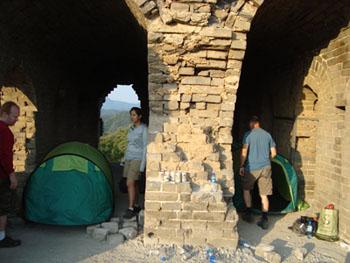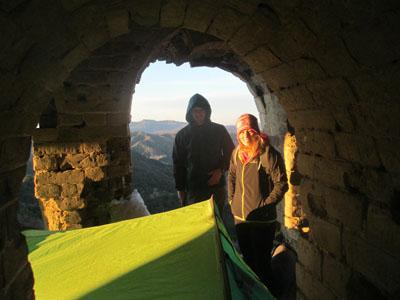 |
The Great Wall of China in Beijing
Sections and Passes
The sections of the Great Wall closest to Beijing are JuYongGuan and BaDaLing. MuTianYu Great Wall is only a little further, but without an expressway to it.
Badaling Great Wall offers awesome views, but it can also be the most crowded (near the entrance), especially at weekends or on national holidays, because it is the most commonly visited by tour groups.
MuTianYu Great Wall is another restored section to the east of BaDaLing, and is also much longer (22km). MuTianYu requires a more rigorous climb, however. Both MuTianYu Great Wall and BaDaLing Great Wall have cable cars to help you reach the top.
JuYongGuan Pass Great Wall is actually a little nearer than Badaling Great Wall. Both cross the same steep-sided valley through which a river, railway line and the Badaling Expressway now pass. The rigorous climb at JuYongGuan is complemented by a number of attractions at ground level. JuYongGuan Great Wall also features some life-size Terracotta Warriors.
Badaling Great Wall Tour
Stretching for 4.8 km along rolling mountains, the BaDaLing section of the Great Wall has 19 strategically located watchtowers. This section was crucial to protect the capital against attack in ancient times, giving BaDaLing the name 'key to the north gate'. The top of the Great Wall here is wide enough in most parts for 10 soldiers to march side by side. The outer parapet is crenellated with melons almost 2 m high.
|
|
Badaling Fortress, at an elevation of 600 m, was built in 1505. The walls around it, built in 1571, are 10 m high, 4 m thick and over 1 km long in circumference. The fortress has 2 gate towers. A tablet inscribed with "Outpost to JuYongGuan Pass" is hung on the eastern gate and another with "The Lock on the Northern Gateway" on the western gate. As the entrance to BaDaLing Great Wall, this fortress is an important defensive spot on the north side of JuYongGuan Pass. During the Ming dynasty, a strong force was garrisoned here.
East of the fortress lies a huge rock, 7 m long and 2 m high, named 'Watching Beijing Rock'. It is said that the Empress Dowager CiXi once passed here as she fled to the north when the Eight Allied Forces invaded Beijing in 1900. Making a short stop here, she looked back towards Beijing and lamented the loss of her comfortable life in the Forbidden City.
In recent years, this section of the Great Wall has been repaired (using traditional materials and techniques) and a Great Wall Museum has been established near to the wall. Over 100 million visitors have walked along BaDaLing Great Wall.
Photo: Los Angeles Clippers visited Badaling in October, 2012 during
their pre-season trip to Beijing with Miami Heat.
Jiankou and Mutianyu Great Wall Tour
Located in HuaiRou County, 70 km northeast of Beijing, the MuTianYu section of the Great Wall lies between JuYongGuan, Badaling, JianKou and HuangHua in the west, and JinShanLing, Simatai and GuBeiKou in the east. One of the best-preserved parts of the Great Wall (and now carefully restored), the MuTianYu section served as part of the northern barrier defending both the capital and the imperial tombs.

First built in the mid-6th century during the Northern Qi dynasty, MuTianYu Great Wall is older than BaDaLing Great Wall. During the Ming dynasty, under the supervision of General Xu Da, construction of the present wall began on the foundations of the Northern Qi wall. In 1404, a gateway was built in the Great Wall here. In 1569, MuTianYu Great Wall was rebuilt.
MuTianYu has the largest construction scale and best overall quality among all sections of the Great Wall.
Built mainly with granite, the wall is 7 - 8 meters high and the top is 4 - 5 meters wide. Compared with other sections of the Great Wall, MuTianYu possesses some unique characteristics in its
construction. Watchtowers are densely placed along this section of the Great Wall - 22 watchtowers in the 2,250 m long wall. That is, one every 100 meters whereas the norm is about one every 500 meters.
Both the outer and inner parapets are crenellated with melons, so that shots could be fired at the enemy on both sides, a feature very rare on other parts of the Great Wall. The MuTianYu Pass itself has 3 watchtowers, a big one in the center and a smaller one on each side. Standing on the same terrace, the 3 watchtowers are connected to each other from inside composing a formidable but rarely seen structure among sections of the Great Wall. MuTianYu Great Wall is surrounded by woodland and streams. The forest coverage is over 90% making for wonderful scenery. A cable car is available to whisk you up onto the Great Wall - which is a good idea given how far along the wall you can then travel.
Simatai Great Wall Tour
A much wilder and less crowded option is to go to the section known as
SiMaTai Great Wall. However, this section is quite a lot further away - over 100 km northeast of Beijing, and part of the journey is along smaller roads through the mountains. The journey time to SiMaTai Great Wall is about 2 1/4 hours.
Higher than BaDaLing, running along a precipitous mountain ridge, and with the extra beauty of being in a weathered, partly crumbled state, the Great Wall at SiMaTai fulfills one's Great Wall dreams and so is well worth the journey. SiMaTai Great Wall is 5.4 km long, has 35 watchtowers and joins with JinShanLing Great Wall to the west. There are many places along the wall here that are unmatched among other sections of the Great Wall.
SiMaTai Great Wall is separated into two parts - east and west - by a valley. The west section is relatively gentle and has 20 well-preserved watchtowers. The east part is precipitous and has 15 rugged watchtowers on 1000 meter high peaks, creating a journey you will surly never forget.
 Jinshanling Great Wall Tour Jinshanling Great Wall Tour
Just to the west of
SiMaTai Great Wall is
JinShanLing Great Wall. Partly restored, JinShanLing Great Wall lies in beautiful scenery that is more rolling and forested, whereas SiMaTai Great Wall is more rugged. JinShanLing is another good choice for a more peaceful Great Wall experience.
Although a bit narrower than BaDaLing and MuTianYu, JinShanLing Great Wall features complicated and well preserved fortification systems. One can hike all the way from JinShanLing to SiMaTai. End to end, the journey is about 30km and requires about 6 hours or so at a leisurely pace.
A good idea for a two, three or four day trip : combine a visit to SiMaTai GreatWall and / or JinShanLingg Great Wall with a visit to ChengDe, the ancient imperial summer resort, that is on the same line of direction from Beijing (about 2 hours drive further). ChengDe contains a huge imperial park, encircled by a charming mini Great Wall, and a number of interesting temples. ChengDe itself is encircled by mountains and is a picturesque place well worth a visit.
Juyongguan Great Wall Tour
JuYongGuan Great Wall is a Pass that lies in an 18 km long valley named GuanGou in ChangPing County, about 55 km from Beijing City. JuYongGuan is one of the three great passes of the Great Wall of China.
In fact, JuYongGuan Great Wall actually has two passes, one to the south and one to the north. The southern one is what we now call JuYongGuan and the northern one is BaDaLing.
JuYongGuan rises steeply each side of a fortified gate that crosses a river (and now a reservoir). There is a temple and other attractions close by JuYongGuan Great Wall also features some life-size Terracotta Warriors.
JuYongGuan Pass was connected into the Great Wall of China during the Northern and Southern Dynasties period. What we see today was initially built during the Ming dynasty and it received much renovation later. It is a very strategically important place connecting inner China with the area near the northern border. JuYongGuan Great Wall was also of major defensive importance for the city of Beijing.
Gubeikou Great Wall Tour
GuBeiKou Great Wall is located in north MiYun County about 150 km north east of Beijing. GuBeiKou provides vital access to a road that runs north-south across the YanShan Mountains. With the PanLong (Coiling Dragon) and WoHu (Crouching Tiger) mountains in the background, this section of the Great Wall is linked to the QingFeng (Green Wind) and DiCui (Piled Verdure) peaks.

The ChaoHe River also runs across the Great Wall here from north to south. The main section of GuBeiKou Great Wall joins the PanLong and WoHu mountains into an integral whole to form an impressively strong fortification. In 1378, the 11th year of HongWu's reign in the Ming dynasty, General Xu Da ordered this section of the Great Wall to be rebuilt and strengthened. Few sections have seen as many battles as GuBeiKou and some of the battles are famous in Chinese history.
On the southern mountain slopes of GuBeiKou Great Wall stands a temple dedicated to Yang Ye, a famous Great Wall garrison general during the Song Dynasty. There are quite a few temples in China dedicated to this general, but this one at GuBeiKou Great Wall is perhaps the earliest.
Great Wall Is Twice Longer
The previous estimate of Great Wall was about 8,850 km. The project in
2012, a joint effort between China’s State Administration of
Cultural Heritage and the State Bureau of Surveying and Mapping,
found the Great Wall stretches through 15 provinces, autonomous
regions and municipalities and goes into
Inner Mongolia. The
Great Wall is twice longer!
>>The best parts of the
Great Wall to visit
>> Choose the best
time to visit the Great Wall
|

